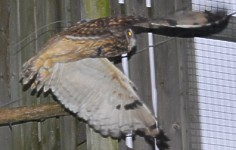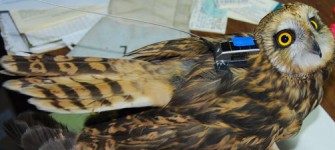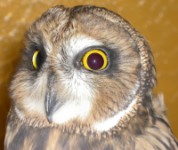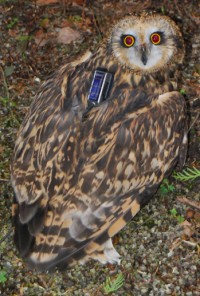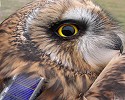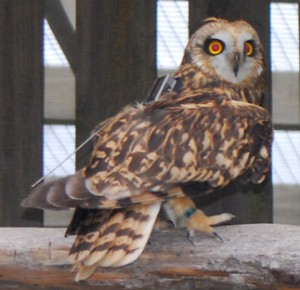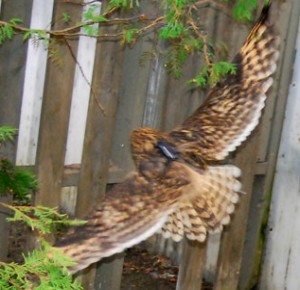|
|
Skor
- rehabilitated at the Owl Foundation in Ontario; released
in Saskatchewan October 2007 |
Scroll
down or click here to access the latest reports on
Skor's movements
|
Background:
The Short-eared Owl has been experiencing a severe population decline over
much of North America. One of the key challenges faced by
conservation efforts is that it is a highly nomadic species
and few details are known about its movements; this also makes it
difficult to accurately assess the population at any given time.
Recent advances in satellite telemetry have resulted in
transmitters finally being small enough to be worn by
Short-eared Owls. This technology now provides a unique
opportunity to investigate this critical issue.
To
our knowledge, the first satellite transmitter was deployed on a
Short-eared Owl in New York in 2006, and only two other
individuals have been tracked since. Results in all cases
have been limited; the reason for this is unknown, but one
possibility is that the back feathers are covering the solar
panels on the transmitters, limiting their ability to gather
enough power to send a signal to the satellites orbiting Earth.
To better
understand what is happening and improve our chances of a
successful tracking effort, we chose to deploy our first
satellite transmitter on an owl in captivity. This
provided an opportunity to monitor the reliability of the
transmitter and make adjustments prior to release.
Also, while previous studies on a variety of other raptor
species have suggested that wearing a satellite transmitter does
not influence behaviour, this also gave us a period of
observation to verify that neither it nor the harness were
inhibiting the bird in any way. An added benefit of this
approach is that relatively little is known about the movements
and survival of birds following rehabilitation, and this
research will begin to provide some insights into this.
The bird
selected for our study is a third-year female named "Skor",
originally rescued by the Saskatoon Veterinary College in Saskatchewan.
In January 2006, she was transferred to the Owl Foundation in
Vineland, Ontario for rehabilitation. Once she had
replaced enough of her damaged feathers to fly effectively, she
was placed in a 75 m long flight cage to strengthen her flight
muscles and resume catching prey. As her moult was not
completed until late in the year, she was held over winter
again, and received extensive flight and hunting training prior
to her release back to Saskatchewan in
October 2007.
The
12-gram transmitter worn by Skor is powered by solar energy, and should
continue broadcasting for at least two to three years.
Although the longevity of Short-eared Owls has not been well
studied, it is generally believed that they are a very
short-lived species, so there is a good chance that the
transmitter may in fact have the longer lifespan. If that
should be the case, we hope to be able to use the opportunity to
learn more about the causes of mortality that threaten this
species.
The raw
satellite telemetry data will come to MRF by e-mail, and we will
provide regular summary updates below, in reverse chronological
order. We will aim to provide updates on roughly a weekly
basis, but may post news sooner if there is a lot of movement,
or somewhat less frequently if the bird remains stationary for
extended periods. Maps will also be updated periodically
to provide a visual overview of Skor's movements.
|
|
Questions
or comments? Please e-mail MRF Research Director Marcel
Gahbauer.
Tax-deductible donations to help us continue and expand this research
program
are
greatly appreciated - click here
for more information
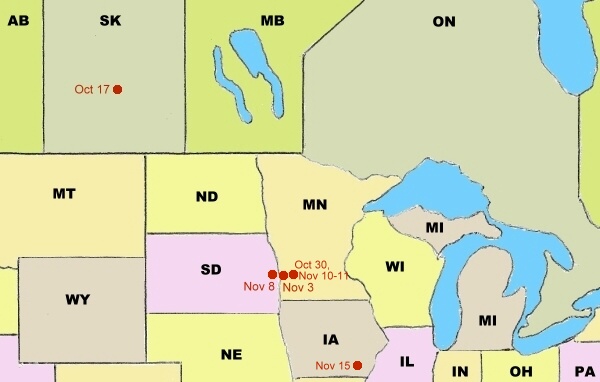
Map last updated 15 November
2007
Reports:
27
January 2008:
Fremont, IA?
Two months have passed since the last data transmission from Skor.
We kept putting off this update, hoping that data would suddenly come
in, as happened following the original period of suspense in October -
but that was only two weeks. Certainly a silence this long is not
encouraging. However, there is also no evidence to suggest that
Skor has perished - from past experience with satellite telemetry
studies of other species, we know that mortalities are often recorded as
a lack of movement by the transmitter; receiving no data at all leaves
the situation less clear. Only a few Short-eared Owls have
previously been studied using satellite telemetry, and in at least two
cases there were long periods of a month of more during which the
transmitter was silent, only to become active again. Considering
that it is powered by solar energy, winter days are shorter, and Skor is
probably spending much of the day seeking shelter, it could well be that
the transmitter simply has not been able to collect enough of a charge
to function. If this is the case, then as days get longer again
and Skor becomes more active heading into migration and then the
breeding season, it could well start broadcasting again. In the
meantime, all we can do is wait and hope. We will post an update
as soon as any data are received.
24
November 2007:
Fremont, IA.
Little has changed, with new reports on November 20 and today showing
that Skor has remained in the same area of southeast Iowa. All
signals have come from within a few kilometres of each other.
Perhaps she has settled into a winter home this time.
15
November 2007:
Fremont, IA.
Skor seems to travel when we're not 'watching'! When we got data
two days in a row, she barely moved; now that there has been a four day
gap between reports, we find that she has made a major shift to the
southeast of over 460 km. Her present position is roughly midway
along and 50 km south of the line connecting Des Moines and Iowa City,
in southeastern Iowa. Although the transmitter has the potential
to provide us with data daily, it only emits a signal when the solar
panels have received a sufficient charge - and that of course can be
influenced by weather, day length (it's a good thing she's heading
south!), and most importantly, Skor's behaviour. Seeking shelter
in concealed places is good for avoiding predators, but tends to limit
the exposure of the transmitter to direct sunlight. While it's
frustrating to be missing out on some of the details of her movements,
the quality of data should remain consistent over a much longer period
than for a battery-powered transmitter - and in any case, the
solar-powered units are the only ones light enough for a Short-eared Owl
to carry. Despite being left to guess at what happened during the
gaps, we have already learned a surprising amount over the first month
of Skor's movements.
11
November 2007:
Marshall,
MN.
Little change in position today, although the latest data show that
Skor is now right along the Redwood River, northeast of Marshall.
While most of the landscape is cultivated, it may be that near the river
she is finding some remnants of the tallgrass prairie that historically
dominated this region.
10
November 2007:
Marshall,
MN.
Apparently South Dakota didn't meet Skor's needs, as she has returned
to the area north of Marshall where she was 11 days ago.
8 November
2007:
Toronto, SD.
No, that isn't a typo! While Skor spent time in rehab at the Owl
Foundation, she was within 50 km of Toronto, Ontario; now that she is
free to explore on her own, she has somehow found her way to within 10
km of the small town of Toronto, South Dakota, population 202. She
is again in an agricultural area, just west of what appears to be a
badland complex, and has moved west 40 km over the past 5 days.
3 November
2007:
Ivanhoe,
MN.
Skor has made a more modest movement since the last update, shifting
24 km west to near Ivanhoe, Minnesota. This is still part of the
largely agricultural landscape that she was in a few days ago.
30
October 2007:
Marshall,
MN.
Well, after keeping us in suspense for nearly two weeks, Skor has
finally checked in with a new location. It would seem that despite
our best attempts to find her a new home in good habitat close to where
she was originally found, she wanted nothing more to do with
Saskatchewan! Her current location is in southwestern Minnesota, a
bit over 200 km west of Minneapolis. Her immediate surroundings
are agricultural fields, but there are some wetlands not too far to the
east. Skor is now 1040 km almost due
southeast of her release site. We have no way of knowing whether
she has been moving steadily or not, but that works out to an average of
80 km per day. Now of course we are all the more intrigued to see
where Skor will go next; hopefully she won't keep us waiting as long
this time.
17
October 2007:
Last Mountain Lake,
SK.
Skor is flying free! After a long period of rehabilitation and
flight training, this third-year female known as Skor has become the
first Short-eared Owl to be tracked by MRF using satellite telemetry.
Our heartfelt thanks to Kay McKeever, Kara Kristjanson, Annick Gionet,
and Cathy Foxcroft at the Owl
Foundation in Ontario, who have put great effort into Skor's rehab,
as well as closely monitoring her behaviour with respect to the
transmitter and harness, and arranging for her transport back to
Saskatchewan. Thanks also to
John Auchie at
WestJet and Blake Henke at
North Star Science and Technology
for clearing Skor to be flown home to Saskatchewan wearing her
transmitter.
Given the nomadic nature of Short-eared Owls
and the fact that Skor had been away for well over a year, returning her
to the exact location where she was picked up was not a priority.
Rather, we decided to pick a site with an abundance of suitable habitat
and a known history of supporting Short-eared Owls, while also
minimizing travel time from the airport. Last Mountain Lake
National Wildlife Area, southeast of Saskatoon and north of Regina, was
a good fit.
The release took place late in the
afternoon. After a quick examination to ensure both owl and
transmitter were in good condition, Skor was released. Her initial
flight took her only a short distance, after which she stood on the
ground for a while taking in her new surroundings. A couple of
further short flights took her deeper into the grass. About an
hour after release, distance and fog conspired to block her from view.
From now on we will rely on technology to keep tabs on her location.
It was a dismally gray day in Saskatchewan,
and the preceding few days in Ontario had been rather cloudy too, so the
transmitter is likely low on power. We will need to wait for a
good sunny period to charge it up before we can expect to receive
telemetry data from it. Watch this page for updates.

A view of the
landscape at Last Mountain Lake, Saskatchewan, where Skor was released
(Photo by Marcel Gahbauer)
April 2007:
Vineland, ON.
The transmitter was attached on April 13, and Skor was released back
into the cage where she has been rehabilitating from her injury last
fall. The photos below show the positioning of the transmitter at
rest and in flight. After two weeks of observation, there appears
to be no indication that she has any discomfort with the harness, and
she has been flying impressively in advance of her release.
|

